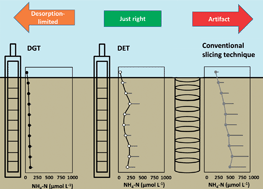Comparison of DET, DGT and conventional porewater extractions for determining nutrient profiles and cycling in stream sediments†
Abstract
Determining inorganic nutrient profiles to support understanding of nitrogen transformations in stream sediments is challenging, due to nitrification and denitrification being confined to particular conditions in potentially heterogeneous sediment influenced by benthic microalgae, rooted aquatic plants and/or diel light cycles. The diffusive gradients in thin films (DGT) and diffusive equilibration in thin films (DET) techniques allow in situ determination of porewater concentration profiles, and distributions for some solutes. In this study, DGT, DET and conventional porewater extraction (sectioning and centrifugation) methods were compared for ammonium and nitrate in stream sediments under light and dark conditions. Two-dimensional distributions of Fe(II) and PO4–P were also provided to indicate the degree of spatial and temporal heterogeneity in sediment porewater, which can explain the sources and sinks of ammonium at various depths in the sediments. Although the conventional porewater extraction method consistently measured higher NH4–N concentrations than the DGT and DET techniques, the study showed that the DET measurements were the most reliable indicator of porewater NH4–N concentrations, with the DGT data being usefully supplementary. However, a large proportion of the NO3–N concentrations measured by DGT and DET were close to or below the method detection limits. Therefore, further development of these techniques is required to reduce the blanks and detection limits to allow natural low sediment porewater NO3–N concentrations to be accurately monitored using DGT and DET. The study indicated that benthic microalgae had direct and indirect influences on porewater nutrient distributions over light–dark cycles. Overall, DGT and DET techniques can be useful for monitoring porewater nutrient concentrations and profiles and for determining how biological processes drive changes in sediment nutrient concentrations and distributions.



 Please wait while we load your content...
Please wait while we load your content...